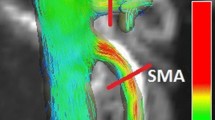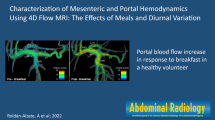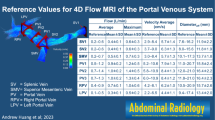Abstract
Purpose
Chronic mesenteric ischemia (CMI) is a rare disease with a particularly difficult diagnosis. In this study, 4D flow MRI is used to quantitatively evaluate mesenteric hemodynamics before and after a meal in patients suspected of having CMI and healthy individuals.
Methods
Nineteen patients suspected of CMI and twenty control subjects were analyzed. Subjects were scanned using a radially undersampled 4D flow MR sequence (PC-VIPR). Flow rates were assessed in the supraceliac (SCAo) and infrarenal aorta, celiac artery, superior mesenteric artery (SMA), left and right renal arteries, superior mesenteric vein (SMV), splenic vein, and portal vein (PV) in a fasting state (preprandial) and 20 min after a 700-kcal meal (postprandial). Patients were subcategorized into positive diagnosis (CMI+, N = 6) and negative diagnosis (CMI−, N = 13) groups based on imaging and clinical findings. Preprandial, postprandial, and percent change in flow rates were compared between subgroups using a Welch t test.
Results
In controls and CMI− patients, SCAo, SMA, SMV, and PV flow increased significantly after meal ingestion. No significant flow increases were observed in CMI+ patients. Percent changes in SMA, SMV, and PV flow were significantly greater in controls compared to CMI+ patients. Additionally, percent changes in flow in the SMV and PV were significantly greater in CMI− patients compared to CMI+ patients.
Conclusions
4D flow MRI with large volumetric coverage demonstrated significant differences in the redistribution of blood flow in SMA, SMV, and PV in CMI+ patients after a meal challenge. This approach may assist in the challenging diagnosis of CMI.





Similar content being viewed by others
Data availability
The datasets used and analyzed during the current study are available from the corresponding author on reasonable request.
Code availability
Not applicable.
References
van Bockel JH, Geelkerken RH, Wasser MN (2001) Chronic splanchnic ischaemia. Best Pract Res Clin Gastroenterol 15 (1):99-119. https://doi.org/10.1053/bega.2001.0158
Kolkman JJ, Geelkerken RH (2017) Diagnosis and treatment of chronic mesenteric ischemia: An update. Best Pract Res Clin Gastroenterol 31 (1):49-57. https://doi.org/10.1016/j.bpg.2017.01.003
Sreenarasimhaiah J (2005) Chronic mesenteric ischemia. Best Pract Res Clin Gastroenterol 19 (2):283-295. https://doi.org/10.1016/j.bpg.2004.11.002
Pillai AK, Kalva SP, Hsu SL, Walker TG, Silberzweig JE, Annamalai G, Baerlocher MO, Mitchell JW, Midia M, Nikolic B, Dariushnia SR (2018) Quality Improvement Guidelines for Mesenteric Angioplasty and Stent Placement for the Treatment of Chronic Mesenteric Ischemia. J Vasc Interv Radiol 29 (5):642-647. https://doi.org/10.1016/j.jvir.2017.11.024
Terlouw LG, Moelker A, Abrahamsen J, Acosta S, Bakker OJ, Baumgartner I, Boyer L, Corcos O, van Dijk LJ, Duran M, Geelkerken RH, Illuminati G, Jackson RW, Kärkkäinen JM, Kolkman JJ, Lönn L, Mazzei MA, Nuzzo A, Pecoraro F, Raupach J, Verhagen HJ, Zech CJ, van Noord D, Bruno MJ (2020) European guidelines on chronic mesenteric ischaemia – joint United European Gastroenterology, European Association for Gastroenterology, Endoscopy and Nutrition, European Society of Gastrointestinal and Abdominal Radiology, Netherlands Association of Hepatogastroenterologists, Hellenic Society of Gastroenterology, Cardiovascular and Interventional Radiological Society of Europe, and Dutch Mesenteric Ischemia Study group clinical guidelines on the diagnosis and treatment of patients with chronic mesenteric ischaemia. United European Gastroenterol J 8 (4):371-395. https://doi.org/10.1177/2050640620916681
Oliva IB, Davarpanah AH, Rybicki FJ, Desjardins B, Flamm SD, Francois CJ, Gerhard-Herman MD, Kalva SP, Ashraf Mansour M, Mohler ER, 3rd, Schenker MP, Weiss C, Dill KE (2013) ACR Appropriateness Criteria (R) imaging of mesenteric ischemia. Abdom Imaging 38 (4):714-719. https://doi.org/10.1007/s00261-012-9975-2
Amin MA, Nooman NA, Moussa GI (2014) Acute and chronic mesenteric ischemia: Multidetector CT and CT angiographic findings. The Egyptian Journal of Radiology and Nuclear Medicine 45 (4):1063-1070. https://doi.org/10.1016/j.ejrnm.2014.06.001
Mazzei MA, Guerrini S, Cioffi Squitieri N, Vindigni C, Imbriaco G, Gentili F, Berritto D, Mazzei FG, Grassi R, Volterrani L (2016) Reperfusion in non-occlusive mesenteric ischaemia (NOMI): effectiveness of CT in an emergency setting. Br J Radiol 89 (1061):20150956-20150956. https://doi.org/10.1259/bjr.20150956
Carlos RC, Stanley JC, Stafford-Johnson D, Prince MR (2001) Interobserver variability in the evaluation of chronic mesenteric ischemia with gadolinium-enhanced MR angiography. Acad Radiol 8 (9):879-887. https://doi.org/10.1016/s1076-6332(03)80767-5
Meaney JF, Prince MR, Nostrant TT, Stanley JC (1997) Gadolinium-enhanced MR angiography of visceral arteries in patients with suspected chronic mesenteric ischemia. J Magn Reson Imaging 7 (1):171-176. https://doi.org/10.1002/jmri.1880070126
Mazzei MA, Guerrini S, Cioffi Squitieri N, Imbriaco G, Chieca R, Civitelli S, Savelli V, Mazzei FG, Volterrani L (2013) Magnetic resonance imaging: is there a role in clinical management for acute ischemic colitis? World journal of gastroenterology 19 (8):1256-1263. https://doi.org/10.3748/wjg.v19.i8.1256
Zwolak RM, Fillinger MF, Walsh DB, LaBombard FE, Musson A, Darling CE, Cronenwett JL (1998) Mesenteric and celiac duplex scanning: a validation study. J Vasc Surg 27 (6):1078-1087; discussion 1088. https://doi.org/10.1016/s0741-5214(98)60010-0
Muller AF (1992) Role of duplex Doppler ultrasound in the assessment of patients with postprandial abdominal pain. Gut 33 (4):460-465. https://doi.org/10.1136/gut.33.4.460
Gentile AT, Moneta GL, Lee RW, Masser PA, Taylor LM, Jr., Porter JM (1995) Usefulness of fasting and postprandial duplex ultrasound examinations for predicting high-grade superior mesenteric artery stenosis. Am J Surg 169 (5):476-479. https://doi.org/10.1016/s0002-9610(99)80198-6
Sabba C, Ferraioli G, Sarin SK, Lerner E, Groszmann RJ, Taylor KJ (1990) Feasibility spectrum for Doppler flowmetry of splanchnic vessels. In normal and cirrhotic populations. J Ultrasound Med 9 (12):705-710. https://doi.org/10.7863/jum.1990.9.12.705
Li KC, Whitney WS, McDonnell CH, Fredrickson JO, Pelc NJ, Dalman RL, Jeffrey RB, Jr. (1994) Chronic mesenteric ischemia: evaluation with phase-contrast cine MR imaging. Radiology 190 (1):175-179. https://doi.org/10.1148/radiology.190.1.8259400
Burkart DJ, Johnson CD, Reading CC, Ehman RL (1995) MR measurements of mesenteric venous flow: prospective evaluation in healthy volunteers and patients with suspected chronic mesenteric ischemia. Radiology 194 (3):801-806. https://doi.org/10.1148/radiology.194.3.7862982
Li KC, Hopkins KL, Dalman RL, Song CK (1995) Simultaneous measurement of flow in the superior mesenteric vein and artery with cine phase-contrast MR imaging: value in diagnosis of chronic mesenteric ischemia. Work in progress. Radiology 194 (2):327-330. https://doi.org/10.1148/radiology.194.2.7824706
Dalman RL, Li KC, Moon WK, Chen I, Zarins CK (1996) Diminished postprandial hyperemia in patients with aortic and mesenteric arterial occlusive disease. Quantification by magnetic resonance flow imaging. Circulation 94 (9 Suppl):Ii206-210
Roldan-Alzate A, Francois CJ, Wieben O, Reeder SB (2016) Emerging Applications of Abdominal 4D Flow MRI. AJR Am J Roentgenol 207 (1):58-66. https://doi.org/10.2214/ajr.15.15995
Siedek F, Giese D, Weiss K, Ekdawi S, Brinkmann S, Schroeder W, Bruns C, Chang DH, Persigehl T, Maintz D, Haneder S (2018) 4D flow MRI for the analysis of celiac trunk and mesenteric artery stenoses. Magn Reson Imaging 53:52-62. https://doi.org/10.1016/j.mri.2018.06.021
Roldan-Alzate A, Frydrychowicz A, Said A, Johnson KM, Francois CJ, Wieben O, Reeder SB (2015) Impaired regulation of portal venous flow in response to a meal challenge as quantified by 4D flow MRI. J Magn Reson Imaging 42 (4):1009-1017. https://doi.org/10.1002/jmri.24886
Someya N, Endo MY, Fukuba Y, Hayashi N (2008) Blood flow responses in celiac and superior mesenteric arteries in the initial phase of digestion. Am J Physiol Regul Integr Comp Physiol 294 (6):R1790-1796. https://doi.org/10.1152/ajpregu.00553.2007
Gu T, Korosec FR, Block WF, Fain SB, Turk Q, Lum D, Zhou Y, Grist TM, Haughton V, Mistretta CA (2005) PC VIPR: a high-speed 3D phase-contrast method for flow quantification and high-resolution angiography. AJNR Am J Neuroradiol 26 (4):743-749
Johnson KM, Markl M (2010) Improved SNR in phase contrast velocimetry with five-point balanced flow encoding. Magn Reson Med 63 (2):349-355. https://doi.org/10.1002/mrm.22202
Liu J, Redmond MJ, Brodsky EK, Alexander AL, Lu A, Thornton FJ, Schulte MJ, Grist TM, Pipe JG, Block WF (2006) Generation and visualization of four-dimensional MR angiography data using an undersampled 3-D projection trajectory. IEEE Trans Med Imaging 25 (2):148-157. https://doi.org/10.1109/tmi.2005.861706
Walker PG, Cranney GB, Scheidegger MB, Waseleski G, Pohost GM, Yoganathan AP (1993) Semiautomated method for noise reduction and background phase error correction in MR phase velocity data. J Magn Reson Imaging 3 (3):521-530. https://doi.org/10.1002/jmri.1880030315
Stalder AF, Russe MF, Frydrychowicz A, Bock J, Hennig J, Markl M (2008) Quantitative 2D and 3D phase contrast MRI: optimized analysis of blood flow and vessel wall parameters. Magn Reson Med 60 (5):1218-1231. https://doi.org/10.1002/mrm.21778
Burkart DJ, Johnson CD, Ehman RL (1993) Correlation of arterial and venous blood flow in the mesenteric system based on MR findings. 1993 ARRS Executive Council Award. AJR Am J Roentgenol 161 (6):1279-1282. https://doi.org/10.2214/ajr.161.6.8249742
Burkart DJ, Johnson CD, Morton MJ, Wolf RL, Ehman RL (1993) Volumetric flow rates in the portal venous system: measurement with cine phase-contrast MR imaging. AJR Am J Roentgenol 160 (5):1113-1118. https://doi.org/10.2214/ajr.160.5.8470589
Moriyasu F, Ban N, Nishida O, Nakamura T, Miyake T, Uchino H, Kanematsu Y, Koizumi S (1986) Clinical application of an ultrasonic duplex system in the quantitative measurement of portal blood flow. J Clin Ultrasound 14 (8):579-588. https://doi.org/10.1002/jcu.1870140802
Cohen J (1988) Statistical power analysis for the behavioral sciences. L. Erlbaum Associates, Hillsdale, N.J.
Les AS, Yeung JJ, Schultz GM, Herfkens RJ, Dalman RL, Taylor CA (2010) Supraceliac and Infrarenal Aortic Flow in Patients with Abdominal Aortic Aneurysms: Mean Flows, Waveforms, and Allometric Scaling Relationships. Cardiovasc Eng Technol 1 (1). https://doi.org/10.1007/s13239-010-0004-8
Taylor CA, Cheng CP, Espinosa LA, Tang BT, Parker D, Herfkens RJ (2002) In vivo quantification of blood flow and wall shear stress in the human abdominal aorta during lower limb exercise. Ann Biomed Eng 30 (3):402-408. https://doi.org/10.1114/1.1476016
Sieber C, Beglinger C, Jaeger K, Hildebrand P, Stalder GA (1991) Regulation of postprandial mesenteric blood flow in humans: evidence for a cholinergic nervous reflex. Gut 32 (4):361-366. https://doi.org/10.1136/gut.32.4.361
Moneta GL, Taylor DC, Helton WS, Mulholland MW, Strandness DE, Jr. (1988) Duplex ultrasound measurement of postprandial intestinal blood flow: effect of meal composition. Gastroenterology 95 (5):1294-1301. https://doi.org/10.1016/0016-5085(88)90364-2
Cooper AM, Braatvedt GD, Qamar MI, Brown H, Thomas DM, Halliwell M, Read AE, Corrall RJ (1991) Fasting and post-prandial splanchnic blood flow is reduced by a somatostatin analogue (octreotide) in man. Clin Sci (Lond) 81 (2):169-175. https://doi.org/10.1042/cs0810169
Nishida O, Moriyasu F, Nakamura T, Ban N, Miura K, Sakai M, Uchino H, Miyake T (1987) Interrelationship between splenic and superior mesenteric venous circulation manifested by transient splenic arterial occlusion using a balloon catheter. Hepatology 7 (3):442-446. https://doi.org/10.1002/hep.1840070305
Gaiani S, Bolondi L, Bassi SL, Santi V, Zironi G, Barbara L (1989) Effect of meal on portal hemodynamics in healthy humans and in patients with chronic liver disease. Hepatology 9 (6):815-819. https://doi.org/10.1002/hep.1840090604
Francois CJ, Lum DP, Johnson KM, Landgraf BR, Bley TA, Reeder SB, Schiebler ML, Grist TM, Wieben O (2011) Renal arteries: isotropic, high-spatial-resolution, unenhanced MR angiography with three-dimensional radial phase contrast. Radiology 258 (1):254-260. https://doi.org/10.1148/radiol.10100443
Wasser MN, Geelkerken RH, Kouwenhoven M, van Bockel JH, Hermans J, Schultze Kool LJ, de Roos A (1996) Systolically gated 3D phase contrast MRA of mesenteric arteries in suspected mesenteric ischemia. J Comput Assist Tomogr 20 (2):262-268. https://doi.org/10.1097/00004728-199603000-00017
Waaler BA, Eriksen M, Toska K (1991) The effect of meal size on postprandial increase in cardiac output. Acta Physiol Scand 142 (1):33-39. https://doi.org/10.1111/j.1748-1716.1991.tb09125.x
Poole JW, Sammartano RJ, Boley SJ (1987) Hemodynamic basis of the pain of chronic mesenteric ischemia. Am J Surg 153 (2):171-176. https://doi.org/10.1016/0002-9610(87)90809-9
Acknowledgements
We gratefully acknowledge the support of GE Healthcare.
Funding
Not applicable.
Author information
Authors and Affiliations
Contributions
GSR reconstructed the 4D flow data, performed image segmentation and data analysis, interpreted the results, and drafted the manuscript. CJF helped design the MRI scanning protocol, provided clinical perspective on abdominal vascular anatomy, assisted in recruitment of subjects, and commented on previous drafts of the manuscript. JS provided perspective on clinical findings and performed search in electronic health records. AR helped design the MRI scanning protocol, assisted in the retrospective collection of subjects, provided expertise for using specialized segmentation and data analysis software, and commented on previous drafts of the manuscript. OW helped design the MRI scanning protocol, provided guidance on the study design and data analysis, and made significant critical revisions to the manuscript. All authors read and approved the final manuscript prior to submission.
Corresponding author
Ethics declarations
Conflict of interest
The University of Wisconsin - Madison receives research support from GE Healthcare. The authors declare that they have no other potential competing interests.
Ethics approval
All procedures performed in studies involving human participants were in accordance with the ethical standards of the institutional research committee and with the 1964 Helsinki declaration and its later amendments or comparable ethical standards. Patients suspected of CMI were scanned for clinical purposes and a University of Wisconsin - Madison Health Sciences IRB approved protocol (PI: Scott Reeder, MD, PhD; Title: Clinical Imaging and Outcomes Research; IRB Tracking Number: 2016-0518) was used to retrospectively analyze those datasets. A separate IRB protocol (PI: Scott Reeder, MD, PhD; Title: Evaluation of Liver Hemodynamics by 5-point 4D Phase Contrast MRA; IRB Tracking Number: H-2010-0035) was used for the prospective recruitment and imaging of healthy volunteers and was approved by the University of Wisconsin - Madison Health Sciences Institutional Review Board. All IRB protocols were compliant with the Health Insurance Portability and Accountability Act (HIPAA).
Consent to participate
Informed consent was obtained from all healthy control participants included in the study. Need for consent from the patient cohorts was waived.
Consent for publication
Not applicable.
Additional information
Publisher's Note
Springer Nature remains neutral with regard to jurisdictional claims in published maps and institutional affiliations.
Rights and permissions
About this article
Cite this article
Roberts, G.S., François, C.J., Starekova, J. et al. Non-invasive assessment of mesenteric hemodynamics in patients with suspected chronic mesenteric ischemia using 4D flow MRI. Abdom Radiol 47, 1684–1698 (2022). https://doi.org/10.1007/s00261-020-02900-0
Received:
Revised:
Accepted:
Published:
Issue Date:
DOI: https://doi.org/10.1007/s00261-020-02900-0




